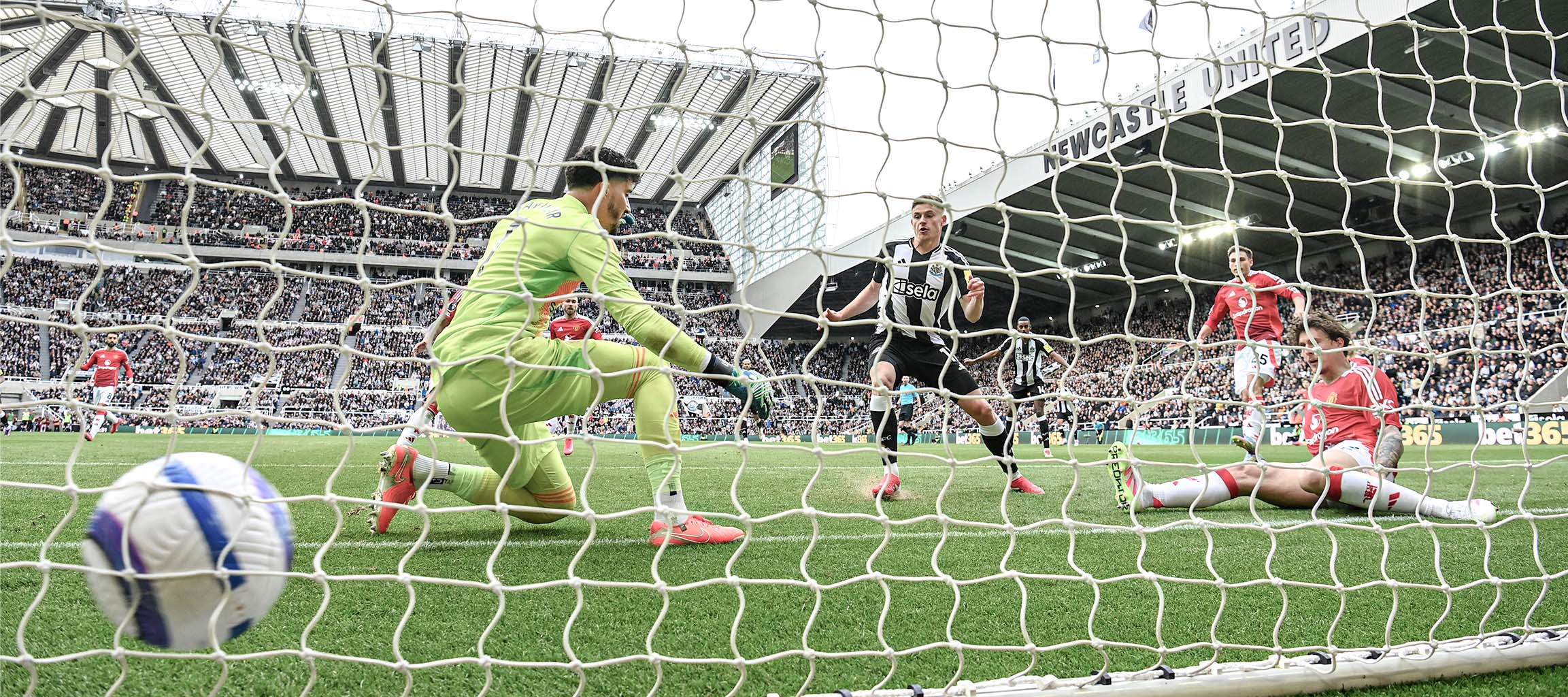
PREMIER League, APRIL 13 2025
Tonaldi (24)
Barnes (49, 64)
Guimarães (77)
Garnacho (37)
Newcastle United boosted their Champions League qualification hopes with this comprehensive victory over struggling Manchester United. With Newcastle manager Eddie Howe absent – having been hospitalised two days earlier after feeling unwell – they were led by his assistant, Jason Tindall. It was certainly a compliment to Howe, as well as his staff and players, that the men in black and white performed so impressively under the circumstances.
Another absentee from the game was Manchester United goalkeeper André Onana, who was left out amid criticism of his performances. His replacement Altay Bayinidir fared little better, at fault as he was for Newcastle’s fourth goal. It would have taken a remarkable goalkeeping performance for the visitors to take anything from this game, though.
Sandro Tonali opened the scoring for the home side with a sweetly struck shot, only for Manchester United to equalise before half-time through an impressive Alejandro Garnacho finish. That parity did not last long, with Harvey Barnes finishing from close range early in the second half, before waltzing through the Red Devils’ defence for his second. Bruno Guimarães put a gloss on the scoreline when Bayindir gave the ball to Joelinton, who headed into the path of the Newcastle captain to score the fourth.
How the managers saw it
“We had to make a couple of tweaks at half-time,” said Tindall. “We felt we were five yards off, especially down the left-hand side, on our press. We could have closed the gaps a little bit quicker to stop the forward passes and credit to the lads because they went out there in the second half with that little tweak and really made a difference. [We had] a lot of regains in the attacking half.”
“We did a lot of mistakes,” said Manchester United head coach Ruben Amorim. “And they were better than us, stronger than us. Suffering the second goal in the beginning of the second half hurt us a lot and then we did mistakes during the game that helped Newcastle to win the game.”
 222133528739141123132152025144117118
22213352873914112313215202514411711812/5
SHOTS / ON TARGET
9/5
50%
POSSESSION
50%
30
ATTACKS INTO AREA
16
2.95
EXPECTED GOALS (XG)
0.62
Newcastle’s high press
In their 4-3-3, Newcastle pressed aggressively when Manchester United were building from deep in a 3-2-4-1. In order to deal with United’s central-midfield box, Newcastle centre-backs Dan Burn and Fabian Schär jumped on to Garnacho and Bruno Fernandes. This meant they supported just behind Tonali and Joelinton, who were covering the visitors’ double pivot. Newcastle’s right-winger Jacob Murphy tracked the wing-back runs of Harry Amass, allowing Kieran Trippier to cover behind the jumping centre-backs, as Guimarães released on to United’s left centre-back. From the left, Barnes pressed inwards, often encouraging a straight pass into the central Manchester United players who were marked and receiving when facing their own goal (below).
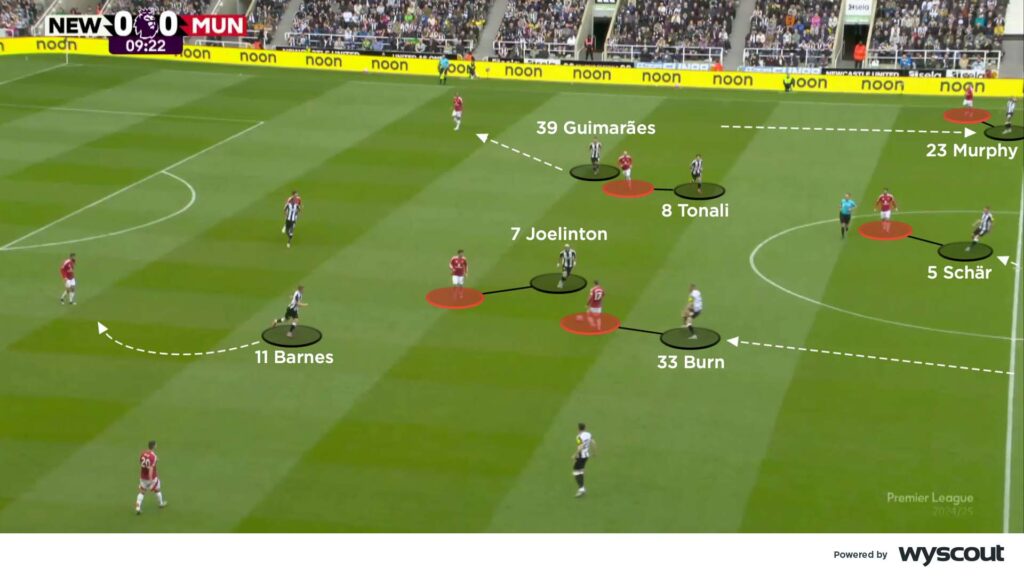
Newcastle’s pressing limited much of Manchester United’s build-up, but also gave them opportunities to attack an expanded back line when they won possession. Along with Tonali and Joelinton, duelling from Newcastle’s centre-backs – who defended well into the visitors’ half – helped win the ball in promising positions. Their narrow attack of Alexander Isak, Barnes and Guimarães was supported in wide areas by Tino Livramento and Murphy (below), as the home side created chances from their high defending.
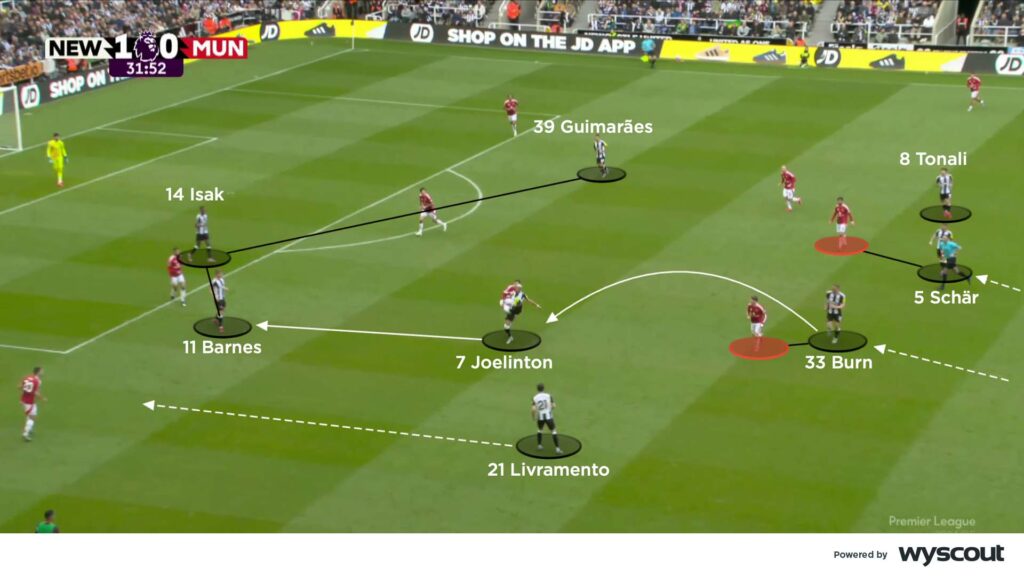
Newcastle tweaked their press in the second half, which included Trippier joining Burn in taking United’s two number 10s. This allowed Schär rather than Trippier to remain in the back line to deal with long balls into the centre-forward. Livramento and Murphy also supported around Schär as they continued to track any advances by Manchester United wing-backs. Guimarães continued to jump with Barnes and Isak as the front-line press; although Manchester United rotated one of their pivots with a wide centre-back, Newcastle’s personnel in that part of their press remained consistent (below).

Newcastle’s aggressive press led to Barnes robbing Noussair Mazraoui to score his second, as well as goalkeeper Bayindir kicking straight to Joelinton for Guimarães to convert from another high regain. Isak’s superb timing and angle of approach helped press the visitors’ goalkeeper, as Victor Lindelöf attempted to move into midfield and overload as an extra pivot. Trippier, Schär and Burn continued with their amended second-half roles even when the opposition tried to rotate their pivots and 10s (below). From here, the hosts’ back line dominated most of the longer passes over their first line. As a result, Manchester United enjoyed little success in building, whether they played short or long.
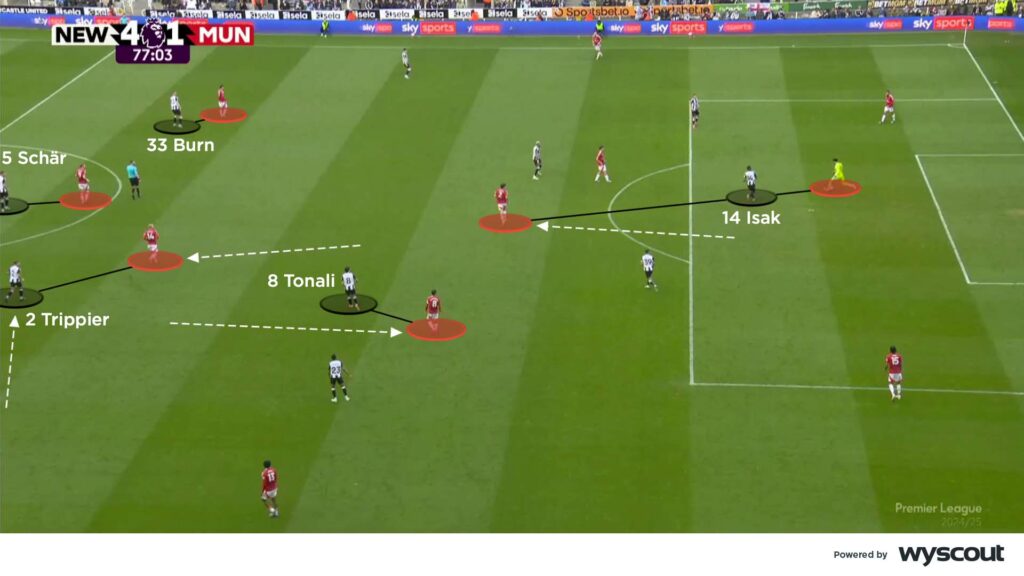
Attacking Manchester United’s back five
With their 4-3-3, Newcastle got numbers around Manchester United’s three centre-backs. Barnes moved inside from the left as early as possible, creating space for Livramento to move forward from left-back. Murphy occasionally provided support around Isak, but because of his deeper defensive positioning he worked in close connection to Trippier, who advanced from right-back. Runners from central midfield often attacked around Manchester United’s central defenders in the first half, especially as the visitors had two pivots and so could not cover all three options from their 5-2-3 defensive block. In this regard, the first goal was an excellent demonstration of Newcastle’s central attacks, with Isak and Tonali linking superbly (below).

Newcastle’s ability to break Manchester United’s double pivot gave them frequent phases of attacking play. From these, Joelinton and Guimarães worked clever, intricate passes into their narrowed attacking teammates. Forward runs from midfield supported the front line in the central spaces, with Trippier and Livramento both keen on getting forward into wide areas as secondary support. That left the two Newcastle centre-backs underneath the ball to stop counters, or reset the play (below).

In the second half, the wide areas became much more fruitful for the home side. Livramento surged forward from left-back, with Barnes often quick to narrow. This meant that Livramento dragged Manchester United’s right wing-back Diogo Dalot away from the rest of his back line, allowing Barnes and the rest of Newcastle’s front line to isolate each centre-back. From here, runners from midfield supported the attack. One would drop out to support underneath Livramento’s advances, or protect on the transition (below).

Trippier also joined attacks from full-back, but operated much more closely with Murphy. As a high full-back he drew out Manchester United’s wing-back, creating space for passes to be slipped inside for Murphy to provide crosses. Barnes continued to attack in a narrow position around Isak, with central midfielders ready to crash the box and occupy the centre-backs (below). With Amorim’s back three dragged further across by Newcastle’s right-sided combinations, this caused the visitors problems.
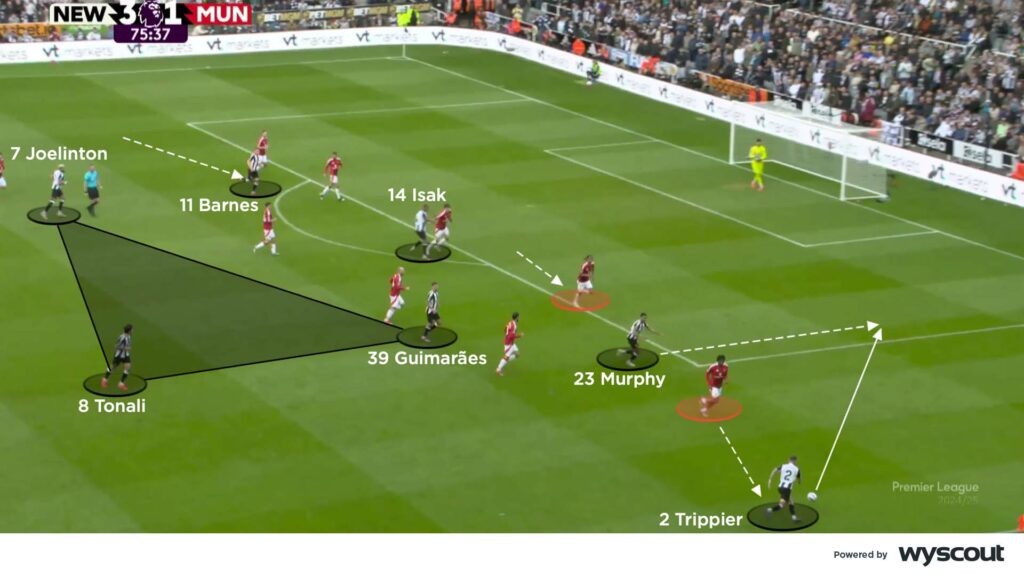
The end result was a commanding performance from Newcastle and a convincing scoreline. It also meant they achieved a league double over Manchester United for the first time since 1930/31. For Ruben Amorim and his team, it is back to the drawing board, with a crunch Europa League tie coming up against Lyon.
To learn more about the game from professional coaches at Coaches’ Voice, visit CV Academy

